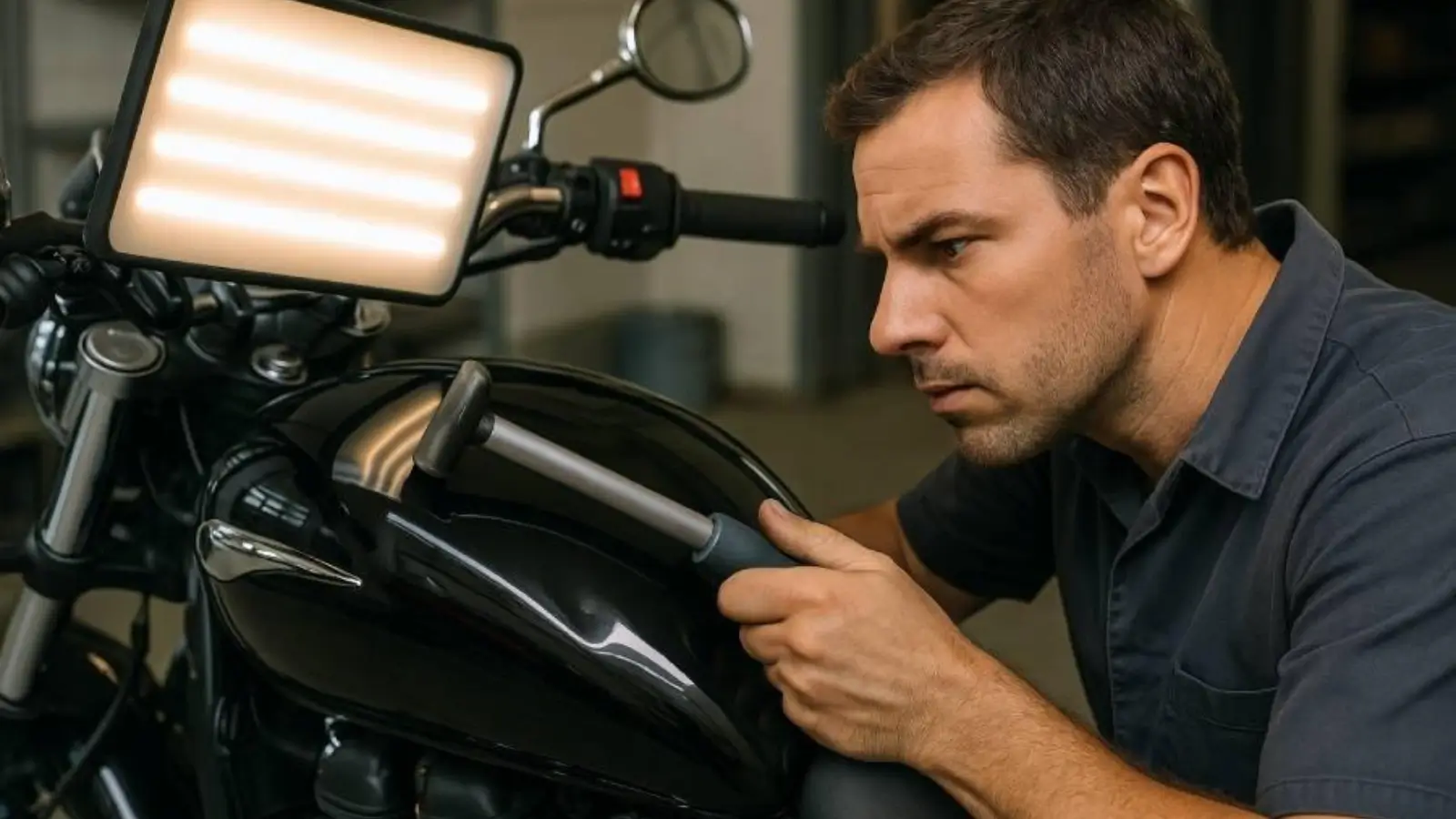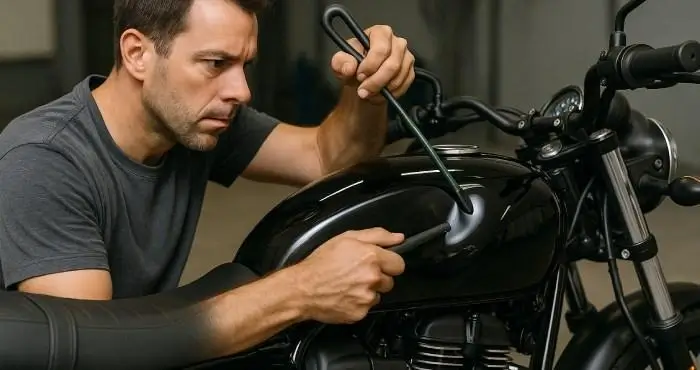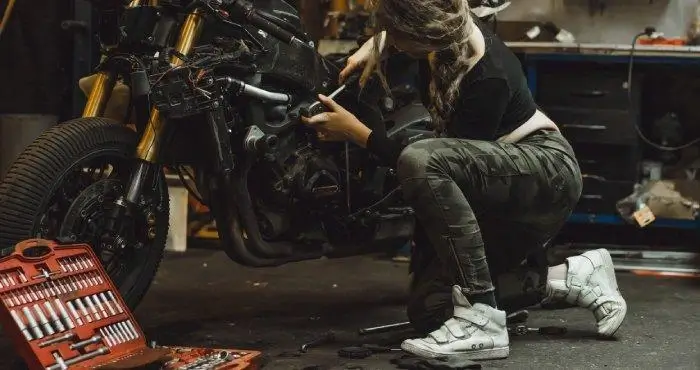


Motorcycle dent repair is an essential skill for riders and enthusiasts alike who want to maintain their bikes in pristine condition. Whether it’s minor damage from accidental drops or hail, or more significant dings resulting from motorcycle accident repair, understanding the best techniques and tools for effective motorcycle dent removal is crucial. This comprehensive guide will cover everything from motorcycle dent types and causes, essential tools, safety precautions, damage assessment, to expert application of paintless dent repair (PDR) techniques.
Before diving into motorcycle dent removal techniques, a thorough motorcycle dent assessment is the first step. Dents on motorcycles can vary widely, influenced by the type of material and the nature of the impact:
Metal Dent Repair: Most motorcycles by manufacturers like Harley-Davidson, Honda Motor Co., and Kawasaki Heavy Industries feature metal body panels requiring precise repair techniques such as panel beating or metal dent repair. These dents often show deformation but minimal paint damage.
Plastic Dent Repair: Some models, including those by Yamaha Motor Company and Suzuki Motor Corporation, use plastic bodywork elements which dent differently. These often need thermal dent removal or specialized plastic dent repair techniques that differ from metal restoration.
Corrosion-Related Dents: Over time, corrosion can weaken panels, making the metal more susceptible to dents and complicating motorcycle corrosion repair efforts.
Scratches and Paint Damage: Alongside dents, motorcycles frequently suffer paint scratches. Proper motorcycle paint touch-up and paint scratch removal are necessary for Original Equipment Manufacturer(OEM)-level restoration.
Causes of dents are also diverse, including impacts from road debris, collisions, ground drops, and mechanical accidents. Proper motorcycle damage inspection helps determine not only the severity of the dent but also its root cause, guiding the repair approach.
Successful DIY dent repair or professional dent repair depends heavily on having the right motorcycle workshop tools and materials. Some indispensable dent repair tools and dent removal kits include:
Suction Cup Dent Remover: This tool is ideal for shallow dents and is widely recommended by experts like James Walker and manufacturers such as Dent Wizard.
Dent Repair Glue Tabs and Dent Removal Adhesives: Used in glue pulling techniques, these tabs pull out small to medium dents without harming paint, a method used extensively in paintless dent repair (PDR).
Heat Gun Dent Repair: Thermal dent removal with heat guns helps restore shape in plastic parts and metal panels without cracking paint, especially useful for plastic dent repair.
Dent Hammer Techniques and Panel Beating Tools: For metal dent repair, traditional techniques involve carefully hammering out dents from the backside, requiring precision tools and expert dent hammer techniques.
Dent Repair Glue Puller Systems: Brands like Glue Puller Pro and DentMagic provide specialized glue pulling kits tailored for motorcycle bodywork.
Automotive Body Repair Supplies: This includes sandpaper, fillers, and motorcycle paint blending paints from DuPont Performance Coatings and BASF Coatings to ensure seamless cosmetic restoration.
Motorcycle Surface Polishing and Detailing Products: After structural repair, polishing and detailing restore luster and finish, complementing any paint scratch removal efforts.
Leading providers of motorcycle dent repair tools, such as BlueSpot Tools, PDR Tools, Kimball Bros, and Dent Pro, regularly offer comprehensive kits catering specifically to motorcycle repair needs.

Motorcycle repair safety must never be overlooked. Whether you’re embarking on DIY dent repair or working in professional motorcycle repair shops, adequate protection and preparation are paramount:
Wear Protective Gear: Gloves, eyewear, and long sleeves can protect against sharp edges and chemical exposure from adhesives or solvents.
Work in a Well-Ventilated Area: Motorcycle paint touch-up and corrosion repair often involve volatile compounds; proper ventilation is necessary.
Use Motorcycle Repair Manuals and Videos: Following manufacturer-specific guides from Yamaha Motor Company or Honda ensures you understand panel construction and avoid inadvertent damage, preventing costly motorcycle dent repair costs.
Ensure Stability of the Motorcycle: Use stands or lifts to stabilize the bike to avoid unwanted movement during dent pulling or hammering.
Be Mindful of Motorcycle Frame Repair: Some dents may have underlying frame issues requiring structural inspection and repair; avoid repairing without professional advice if the frame is compromised.
Correctly judging whether a dent can be resolved through DIY dent repair or requires professional dent repair is critical to preserving motorcycle bodywork and controlling repair costs.
Minor, shallow dents on metal or plastic surfaces without extensive paint damage.
Dents on removable panels where you have access for glue pulling or suction cup dent removers.
Small scratches or paint blemishes addressed through motorcycle paint touch-up and motorcycle surface polishing.
Enthusiasts engaging in motorcycle customization who want to maintain or improve aesthetics as part of motorcycle maintenance routines.
Extensive dents involving motorcycle frame repair or motorcycle body panel replacement.
Damage accompanied by paint cracking or significant corrosion that requires motorcycle corrosion repair techniques.
Complex dents that require panel beating or sophisticated paint blending using products from BASF Coatings or DuPont Performance Coatings.
Damage noted during motorcycle accident repair that might impair safety or structural integrity.
Paintless dent repair (PDR) has revolutionized motorcycle dent removal by enabling restoration without affecting the original paint finish. This environmentally friendly technique is widely adopted for metal dent repair due to its efficiency and excellent results.
PDR involves massaging the dent from behind the panel or using dent pulling techniques on the surface without breaking paint. This is accomplished with specific dent repair tools:
PDR Rods and Picks: Delivered by companies like PDR Nation and PDR Tools, these specially designed rods reach inside panels to gently apply pressure.
Dent Pullers with Glue Tabs: Using dent repair glue tabs and dent removal adhesives such as those from Accubond, technicians attach tabs to the dent surface, then pull it out with controlled force, preserving original paint.
Combining PDR with heat gun dent repair can soften plastic body panels or metal for easier reshaping. Thermal dent removal is particularly effective on plastic-coated surfaces or motorcycle plastic dent repair scenarios.
Maintains factory paint quality with no need for repainting, preserving motorcycle protective coatings.
Short turnaround time compared to traditional panel beating.
Lower motorcycle dent repair cost compared to body panel replacement or repainting.
Ideal for cosmetic restoration in motorcycle detailing and motorcycle customization projects.
Dent repair training is crucial for mastering PDR. Numerous motorcycle repair videos and courses by experts such as James Walker and Dent Magic provide detailed instructions on dent hammer techniques and glue puller operation. Supplementing hands-on experience with motorcycle repair manuals tailored to models from Kawasaki Heavy Industries or Harley-Davidson promotes confidence in applying paintless dent repair safely and effectively.

One of the most effective approaches in motorcycle dent removal is the application of heat and cold methods, especially useful in addressing minor to moderate dents in motorcycle bodywork. Heat gun dent repair leverages controlled thermal expansion to soften the metal or plastic panel, making dents more pliable for reshaping. Devices such as heat guns from brands like Mityvac or industrial heat tools recommended by PDR Nation offer precise temperature control to avoid overexposure that might damage the paint or underlying structure.
Conversely, rapid cooling techniques involve using compressed air or cooled sprays to contract the material quickly, sometimes causing the dented metal to pop back into place due to differing expansion and contraction rates. This thermal dent removal method is often combined with dent pulling techniques for highly effective metal dent repair, particularly for motorcycles with aluminum or alloy panels, as found in Harley-Davidson or Yamaha Motor Company models.
When dents are too deep or involve damage to the motorcycle frame or body panels beyond the scope of paintless dent repair, traditional automotive body repair techniques become necessary. Filling and sanding are pivotal in restoring the motorcycle surface before refinishing.
After a thorough motorcycle dent assessment, using panel beating techniques to realign the metal surface is followed by application of specialized fillers — typically body fillers or putty designed for motorcycle plastic dent repair or metal. Quality dent repair kits from Dent Pro, BlueSpot Tools, or Dent Wizard include filling compounds suited for diverse substrate materials. These fillers must be applied evenly and left to cure properly as per manufacturer guidelines.
Sanding then follows, using graded sandpaper or sanding blocks, often included in motorcycle workshop tools. Proper sanding ensures a smooth surface ready for paint blending and minimizing imperfections. Professionals often recommend starting with coarser grits and progressively moving to finer grits during motorcycle surface restoration to achieve optimal smoothness without damaging the surrounding surface. Check out the DentWerx for gaining further insight.
Once the dent has been filled and sanded, attention turns to the paintwork. Motorcycle paint touch-up is essential for preserving the aesthetic and protective qualities of the bodywork. Paint blending techniques are particularly critical on models such as Honda Motor Co. or Suzuki Motor Corporation motorcycles, where precise color matching is vital.
Removing paint scratches using paint scratch removal tools from suppliers like Accubond or DentMagic can complement paintless dent repair results by recovering the finish without full repainting. Professional motorcycle repair shops and DIY enthusiasts alike employ motorcycle paint touch-up paints developed by BASF Coatings and DuPont Performance Coatings to maintain color fidelity and durability.